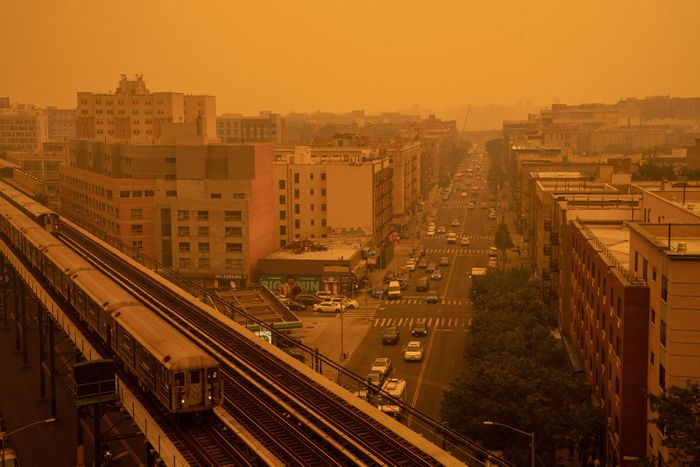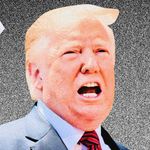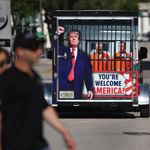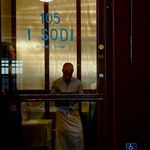
In my memory, my youngest child’s earliest milestones all smell like smoke, spicy and unplaceable, thick enough to lick off my lips. He was born in September 2017, days after the La Tuna Fire, the largest wildfire Los Angeles had seen in half a century, ignited in the foothills a few miles from our house. At the time, I believed wildfires followed a predictable rhythm: sparking in dry summer, raging through fall, and fully, thankfully, extinguished by winter. But come that December, as he smiled and slept through the night, the Thomas Fire — one of a dozen that whipped through the L.A. region that month — ignited and burned well into 2018. That year ended up being the deadliest and most destructive in California fire history, and shortly after his 1st birthday, as the Woolsey Fire roared over the Santa Monica Mountains, he got a runny nose and a cough that lasted for two months. When he was almost 2, our doctor recommended getting tubes in his ears to prevent recurrent infections. It wasn’t until after the surgery that I even considered the potential connection. He had been born into flames.
Right now, New York City is similarly enveloped. “We must act now to protect our city, our environment, and the future of our children,” Eric Adams said on Wednesday, a full 24 hours after the air had been deemed unhealthy for the city’s kids, who had played outside at schools on Tuesday, and 36 hours after meteorologists released stunningly accurate predictions for when the smoke descending through the atmosphere would become extremely hazardous to breathe. The mayor claimed there was no “blueprint or playbook” for this kind of “unprecedented” event, which is plainly untrue. My family has been living it for nearly six years.
Worsening air pollution is among the most deadly of our perpetual climate disasters, killing as many as 7 million people globally each year. But wildfire smoke — a mix of toxic gas and particulate matter — is especially pernicious because of the way it enters the bloodstream. Since Australia’s catastrophic 2019–20 fire season, “Black Summer,” scientific studies have followed hundreds of children who lived through — or were born immediately after — the event; some babies were delivered with blackened placentas. What the evidence shows, conclusively, is that premature labor, low birth weight, impaired lung development, and chronic respiratory issues that require a lifetime of medical intervention can be directly attributed to exposure to wildfire smoke. It’s why I’ve become obsessed with air quality. During the really bad fire year, I bought purifiers — you can also make your own, with materials easily obtained from any hardware store, in about 20 minutes — and positioned one in the bedroom my two kids share. When COVID first hit, many of us in California had masks and respirators on hand already — a hedge against having to evacuate or spending a prolonged period outside during events with a high air-quality index, or AQI. I programmed my phone to bombard me with air-quality alerts. At first, this took some figuring out, but now we have datasets in most weather apps. When the AQI hits 100 — the kids know that the app’s orange warning denoting “unhealthy for sensitive groups” means them — we stay inside.
Of course, this isn’t something that can be, or should be, navigated alone. Mayors can’t assume, as their “Stay indoors” messaging often does, that everyone has access to safer air. Living in an apartment with poorly insulated doors and windows can be just as bad as being outside, which is the only choice for people who make a living outdoors or a city’s unsheltered homeless population. Large-scale interventions to make sure the city’s most vulnerable residents have options for being inside well-filtered spaces, when done right, can protect against many public-health issues at once. During smoke events, cities up and down the West Coast open clean-air refuge centers, often doubling as cooling centers that offer a similar respite during heat waves. Our school district used pandemic-relief funding to overhaul classroom ventilation systems with the explicit reasoning that it would also protect kids on everyday bad-air days, which have become more frequent in the past few years. There’s a major legislative push out here to protect outdoor laborers — particularly farmworkers — from being forced to work in dangerous fire-related conditions. In comparison, Adams has employees working outside in increasingly hazardous air (Philadelphia gave sanitation workers the day off; New York City proudly noted there would be no delay in trash pickup), public schools are severely lagging in ventilation upgrades, and the city is closing libraries and other public buildings that could provide relief for people struggling to keep smoke out of their apartments. (These spaces also provide, crucially, a change of scenery for weary parents stuck indoors.) These efforts should be citywide, but the mayor’s office knows which neighborhoods are most in need of such resources: low-income, predominantly Black and immigrant communities that already experience air-quality disparities on non-smoky days.
These days — especially now that public schools are going remote tomorrow — will be long and difficult for families in small apartments. During 2020’s worst fires, COVID left us with no malls or museums to escape to, and the playgrounds were tempting. We took a lot of themed baths and showers instead. Beyond that, there’s no real advice that I can give — just what I wish someone had told me during those early years. Climate change, like COVID, is a visceral reminder of how porous our crises really are. When smoke from a fire a continent away can dye the Manhattan skyline a toxic orange, it seems more plausible that we’ll all experience the “unprecedented” eventually. But this connection also allows us to learn from one another. Like extreme-heat events, in which it takes months or years to calculate excess deaths and upticks in emergency-room visits or an increase in chronic illnesses, we won’t know the full impact of this week’s wildfire smoke for some time, if ever. But we do know what can be done now to protect people. Take it from Californians, who have been through this enough times to see how our families pay the price: Prepare as if your life depended on it. The Adams administration is botching this smoke event. Of course, it’ll get another chance, soon enough, to try again.


